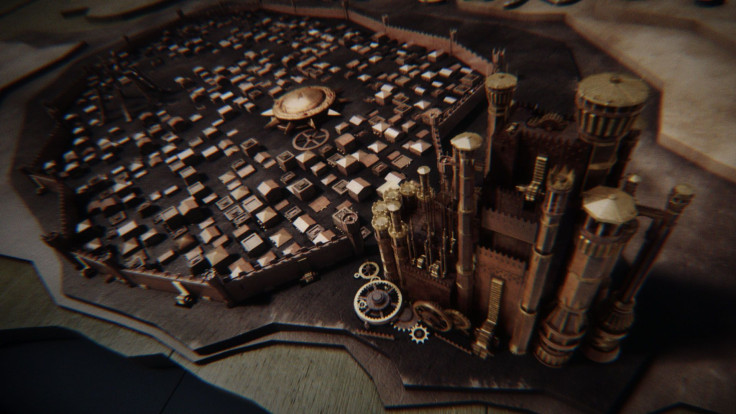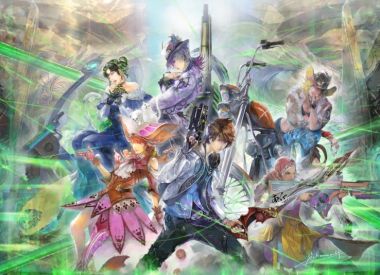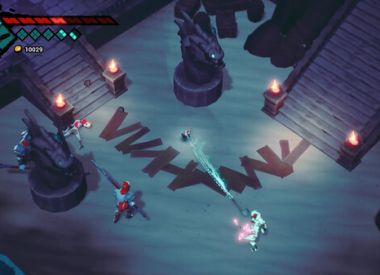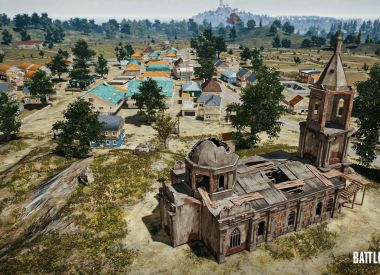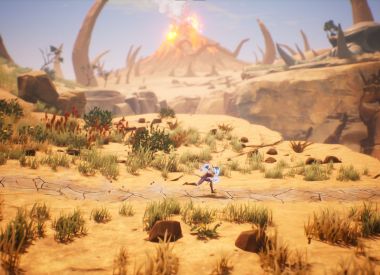Dark leather and furs. Towering castles with austere stone chambers. House sigils over hammered metal breastplates. Gray skies, rolling green hills and ice. Blood. Scowls. Wine. There’s an aesthetic to Game of Thrones — a visual language of muted colors, underplayed magic and ragged people (except the privileged few) that defines not just the HBO series, but our collective notion of the fantasy genre in 2017. And with several Game of Thrones prequels in development at HBO, overseen by A Song of Ice and Fire series author George R.R. Martin, the primacy of the Game of Thrones vision is assured.
But there are other possibilities.
The new Game of Thrones series could explore not just new storylines in Westeros and Essos (the continent across the Narrow Sea), but whole new ways of visualizing the world Martin created in his A Song of Ice and Fire series — A Game of Thrones, A Clash of Kings, A Storm of Swords, A Feast for Crows and A Dance with Dragons (so far). Following in the wake of one of the biggest, most visually lush TV shows of all time, HBO has a rare opportunity to reimagine Westeros entirely. But how do you break loose of something with the gravitational pull of Game of Thrones?
Player.One spoke with The World of Ice & Fire co-authors Linda Antonsson and Elio M. García Jr., who worked closely with George R.R. Martin to co-author a guide to his realms, about imagining GRRM’s Westeros beyond the bounds of HBO's Game of Thrones.
After writing Martin for permission to roleplay in the world of A Song of Ice and Fire, García and Antonsson found the author more receptive than they’d expected. Soon Martin sent over notes about the world and its history, complete with detailed information on heraldic arms and shields. From this was born Westeros.org and A Wiki of Ice and Fire.
“Our goal has always been to visualize something as close to what George visualizes as possible,” Antonsson says. She first read Game of Thrones in 1996, imagining a Westeros not yet defined by the show, which wouldn’t premiere until 2011. For Antonsson, Game of Thrones’ biggest missed opportunity was in not playing up the contrast that defined Martin’s novels, between the pomp of chivalric ideals and the muddy truth of violence.
“A lot of things that happen in Westeros there's this feeling of things being gray and dark and people dying in not-pretty fashions,” Antonsson said. “But with the books it's very much playing up the contrast — the look of the chivalric era, with all the colors and all the banners and everyone looking all grand. The pageantry. And contrasting that with the ugliness, the reality of war. You don't really get that contrast on the show.”
Antonsson cited a short essay Martin wrote for his official page, titled “On Fantasy.” In it, Martin writes “the best fantasy is written in the language of dreams.” He goes on to say:
Fantasy is silver and scarlet, indigo and azure, obsidian veined with gold and lapis lazuli. Reality is plywood and plastic, done up in mud brown and olive drab. Fantasy tastes of habaneros and honey, cinnamon and cloves, rare red meat and wines as sweet as summer. Reality is beans and tofu, and ashes at the end. Reality is the strip malls of Burbank, the smokestacks of Cleveland, a parking garage in Newark. Fantasy is the towers of Minas Tirith, the ancient stones of Gormenghast, the halls of Camelot.
“We read fantasy to find the colors again, I think,” Martin concludes.
Remember the Hand’s Tourney, held in honor of Eddard Stark’s appointment to Hand of the King? On Game of Thrones it’s a straightforward affair, a few rows of benches and spectators lined along a well-trod jousting run. The most memorable part wasn’t the pageantry or the tournament itself, but the fight that broke out between Sandor and Gregor Clegane after “The Mountain” was unhorsed by Loras Tyrell. Antonsson cites that tournament, a far lusher affair in the Game of Thrones novel, as one example of the different attitude Martin takes to fantasy than the show based on his work. “I think George thought of his tournament as kind of like the tournament in Ivanhoe,” she said. “Technicolor and really pretty.”
This could even be extended to how a future series set in Westeros handles war. Rather than trying to top Game of Thrones, which already features the most astounding battles in TV history, with many more promised in the final two seasons, subsequent series could pursue a different aesthetic entirely.
“In the show, if you’re in the Lannister army or the Northern army you wear your normal clothing or your Lannister clothing,” Antonsson says. But that’s missing out on the clannish, house-based systems of fealty and war-making that define Westerosi politics. Martin, an avid collector of medieval miniatures, offers a dizzying variety of chivalric possibilities to separate subsequent series from Game of Thrones. “Everyone would be wearing their different Lords’ livery,” Antonsson said. “You’d be seeing all these different banners as opposed to just seeing the Stark banner or the Lannister banner.”
There’s also a side to George R.R. Martin and A Song of Ice and Fire barely glimpsed in Game of Thrones: his love of science fiction and horror (The Frankensteinian Ser Robert Strong being a major exception), which he set loose on The World of Ice & Fire. “When he moved out east he allowed himself to delve into his Vance-ian side and really allowed himself to be inspired by Jack Vance and Lovecraft,” Antonsson said. “ He doesn't want everything in his world to be known. He wants to be the sense that over the next hill there is something undiscovered and then there's another hill with something undiscovered.”
In-development Game of Thrones prequels have an opportunity not just to distinguish themselves from the look and feel of the HBO series, but to tell entirely different stories, thinking outside of epic fantasy and its markers. With Martin involved in the pre-production, all five potential prequel series to Game of Thrones are likely to bear the strong mark of his influence, which has always imagined Westeros far beyond the confines of the show.
During a Season 1 set visit, García asked Martin “‘is there anything here that kind of supplants your own vision?’ And he said ‘no, not really,’ because the characters, the locations, Westeros has been in his head since 1991. It’s been with him this entire time.” (With one exception: Martin preferred the show’s Moon Door, set in the floor of The Eyrie, rather than a wall. “I wish I had thought of that,” García remembers him saying.)
In a blog post titled “ About Those Spinoffs… ” Martin writes:
“What we’re talking about are new stories set in the “secondary universe” (to borrow Tolkien’s term) of Westeros and the world beyond, the world I created for A Song of Ice and Fire . It is a world, and a pretty big one, and if there were eight million stories in the naked city back in the 50s, just think how many more there are in an entire world, and one with thousands of years of recorded history.”
We can already make some educated guesses about what stories will be told. Since Martin has been busy writing Fire and Blood, the complete history of the Targaryen family he calls his “GRRMarillion,” one of the more likely stories would follow a member of that long-lived, blood-soaked house.
My artwork for The World of Ice and Fire "The Brides of Maegor the Cruel"#twoiaf #asoiaf #agot pic.twitter.com/kW8af3p3eY
— Magali Villeneuve (@Cathaoir1) February 14, 2017
Even if a new series once again follows the rising and tumbling fortunes of political dynasties, a reimagined Westeros, lead by a different showrunner, still has the opportunity to imagine a radically different fantasy. HBO just needs to follow Martin down different garden paths, thwarting our rigid expectations of a Game of Thrones series by offering something unexpected. “George is a gardener, not an architect,” García said, describing Martin’s writing process while working on World of Ice & Fire. Rather than mapping out everything, Martin plants “the seeds of ideas of things he wants to explore.”
- Fully realized, intricate world
- Compelling characters
- Plot twists you won't see coming
- Lots of ground to cover if you're new to the series
- Don't get too attached to anyone
- Two words: Sand Snakes


